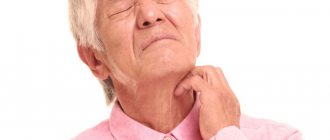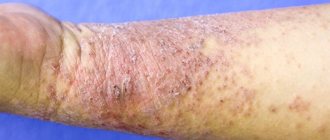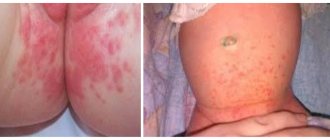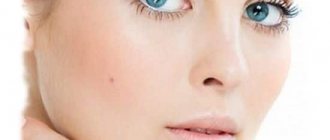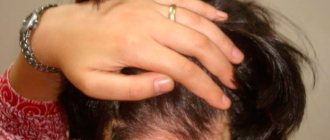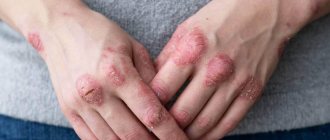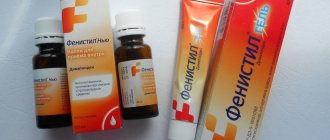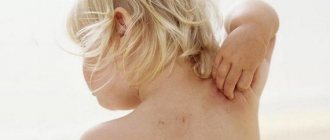Perioral dermatitis
Perioral dermatitis on the face is a disease that affects the skin.
It appears in the form of small pimples that form in the area of the lips and mouth. It is accompanied by unpleasant itching, redness and negative consequences, which can be eliminated through a medical examination and properly selected treatment. In each specific situation, based on the results of the consultation, doctors recommend the patient medications that are relevant to his case. These include specialized pastes, ointments, sometimes hormonal drugs, as well as therapy that quickly eliminates burning and other symptoms. For perioral dermatitis, medications (ointment, tablets, cream) are selected based on medical diagnosis and tests. You can purchase the necessary medications for treatment on our website “Pharmacy 911”.
Symptoms of perioral dermatitis include redness and tenderness around the mouth. The skin becomes increasingly irritated, especially after contact with foods and skin care products, and inflammation may manifest as scaly, papular eruptions (Figure 1).
Fig. 1 Classic case with typical localization. Papules and pustules are located around the mouth and chin.
Occlusive care of the skin around the eyes in combination with makeup leads to overhydration of the skin, and then to increased sensitivity. Thus, similar symptoms occur around the eyes. In this case, the skin of the eyelids is especially susceptible to irritation (Fig. 2).
Fig.2. Papular rash in the eye area.
What appears to be a contact allergy is usually an irritation caused by physicochemical factors and, to a lesser extent, by specific substances. It's a good news. The bad news is that these non-specific skin reactions require stopping the use of skin care products for some time, which is quite unpleasant as the skin becomes dehydrated and feels tight. A dermatologist is often contacted at an early stage. And if a bacterial infection is suspected, antibiotics such as minocycline, erythromycin, doxycycline and others are prescribed.
Fast, but with short-term effect
Corticosteroids are prescribed to control inflammation for a short period of time. They provide temporary relief, but in the long term tend to have a boomerang effect as they make the skin even more sensitive. The protective barrier of the skin is not restored, irritants, allergens, and opportunistic microbes penetrate the skin, resulting in further damage. The disease is progressing. The situation can be compared to rosacea, where corticoids are also contraindicated [1].
Important: when a patient (the disease occurs mainly in women) consults a specialist, she must inform not only about the drug treatment, but also about the skin care products she uses. Oil-in-water emulsions (O/W emulsions) are not tolerated by such patients, since the components of the aqueous phase, after drying, irritate the damaged skin barrier. Preservatives and fragrances contained in emulsions have a sensitizing effect. On the other hand, water-in-oil emulsions (W/O emulsions) that are high in fats and oils promote the proliferation of anaerobic bacteria - the same types found in rosacea and acne. Understanding these relationships, an experienced cosmetologist will have to dispel the patient’s expectations that her treatment program will include a magic remedy that can instantly solve all problems. On the contrary, as mentioned above, the cosmetologist will recommend abandoning all the products used.
Minimalist approach
Giving up all skincare creams in order to take control of unbalanced skin is a challenge for both parties. A minimalist approach to caring for such skin focuses exclusively on the use of small amounts of serums with water-soluble biologically active substances:
- Azelaic acid (Fig. 3) (in the International Nomenclature of Cosmetic Ingredients (INCI): Azelaic Acid), is a 5-alpha reductase inhibitor, inhibits the development of anaerobic bacteria Propionibacterium acnes and Staphylococcus epidermidis. The Federal Institute for Risk Assessment (BfR, Germany) suggests using it in skin care products in an amount of no more than 1% [2]. To ensure sufficient transport of this substance into the skin, liposomal solutions are recommended.
Fig.3. Structure of azelaic acid.
- Proteases are enzymes that break down protein substances. Skin proteases are activated by ultraviolet radiation or inflammatory processes. Therefore, protease inhibitors are indicated for various skin inflammations and at the risk of photodamage to the skin. Effective protease inhibitors are boswellic acids (Fig. 4) [3] from the resin of frankincense, for example Boswellia serrata. To ensure sufficient bioavailability at moderate concentrations, transport particles - biodegradable nanodispersions - are recommended.
Fig.4. Structure of boswellic acid.
- The enzyme 5-lipoxygenase oxidizes arachidonic acid to 5-hydroperoxyeicosatetraenoic acid (arachidonic acid 5-hydroperoxide; 5-HPETE), which subsequently produces the leukotrienes LTA4, LTB4, LTC4, LTD4, and LTE4, which promote inflammation. Boswellic acids (frankincense) can also be used as 5-lipoxygenase inhibitors in cosmetics. But the extent to which the results obtained in vitro apply to lipoxygenase inhibition in vivo remains open. However, boswellic acids have been proven to have a significant anti-inflammatory effect in the treatment of rosacea. Note: Minocycline is used in medical therapy as a 5-lipoxygenase inhibitor.
- Vitamin B3 (Fig. 5) (in the International Nomenclature of Cosmetic Ingredients (INCI): Niacinamide) is used in cosmetology for skin regeneration. In addition, vitamin B3 has an anti-inflammatory effect comparable to clindamycin, which is used in the treatment of Akne vulgaris to suppress the activity of anaerobic microflora, similar to perioral dermatitis [5,6].
Rice. 5. Structure of niacinamide.
- Provitamin B5 (Fig. 6) (in the International Nomenclature of Cosmetic Ingredients (INCI): D-Panthenol), is a precursor of pantothenic acid, improves skin hydration. In pharmaceuticals, for the treatment of inflammatory processes, provitamin B5 is used in the same concentrations as in cosmetology [7]. For various skin lesions, D-Panthenol promotes increased cellular renewal, stimulation of epithelization, and reduction of itching.
Fig.6. Structure of D-panthenol.
- Vitamin A (Fig. 7) (in the International Nomenclature of Cosmetic Ingredients (INCI): Retinol) and its derivatives stimulate cell division and collagen synthesis in epithelial tissue. Retinoids have a threshold for skin irritation. In this regard, treatment should begin with low doses. With standard cosmetic use, the level of permissible concentrations is not achieved. However, the Federal Institute for Risk Assessment (BfR, Germany) recommends limiting the use of vitamin A in face and hand care products [8].
Rice. 7. Structure of vitamin A (retinyl ester - Retinyl Acetate).
In cases where the symptoms of perioral dermatitis are accompanied by rosacea-like symptoms and capillary circulation disturbances are observed, it is worth considering the use of the following biologically active substances.
- Tranexamic acid (Fig.
 (in the International Nomenclature of Cosmetic Ingredients (INCI): Tranexamic Acid) is used in a maximum concentration of 2% in liposomal serums. Its main area of application in cosmetology is hyperpigmentation [9], in addition, this acid with antifibrinolytic effect stabilizes damaged capillaries , thereby reducing redness.
(in the International Nomenclature of Cosmetic Ingredients (INCI): Tranexamic Acid) is used in a maximum concentration of 2% in liposomal serums. Its main area of application in cosmetology is hyperpigmentation [9], in addition, this acid with antifibrinolytic effect stabilizes damaged capillaries , thereby reducing redness.
Fig.8. Structure of tranexamic acid.
- Saponins from extracts of Butcher's broom (Fig. 9) and Kigelia strengthen connective tissue [10].
Fig.9. Structure of saponins from Butcher's broom extract.
- Echinacea extract (Fig. 10), due to the content of unsaturated fatty acid amides, acts as an immunomodulator [11] and supports recovery processes in both rosacea and perioral dermatitis.
Since at the initial stage of recovery the skin may be accompanied by dryness, a feeling of tightness, and cracking, it is recommended to use serums (Fig. 10) with astringent properties. Such serums contain tannins, tannins and polyphenols, which interact with the surface proteins of the skin and thus strengthen it.
Rice. 10. Serums based on plant extracts.
- Green tea extract contains caffeine, polyphenols, bioflavonoids, tannins.
- Witch hazel extract contains flavonoids and tannins.
- Horsetail extract is rich in silicic acid, saponins and bioflavonoids.
- Grape seed extract contains oligomeric proanthocyanidins (OPCs) and catechins, also classified as polyphenols.
Systematic treatment in moderation.
The wide range of biologically active substances naturally encourages the desire to mix all the serums in one product. In this case, the concentration of individual biological active substances will inevitably be reduced so much that their effect will be reduced to zero. Priorities need to be set. The judicious use of small amounts of serums should be adhered to if the goal is to achieve rapid results.
During the inflammatory phase, special attention must be paid to protease, reductase and lipoxygenase inhibitors. After reducing inflammation, you can move on to vitamins A, B3, B5 that stimulate regeneration and connective tissue stabilizing serums. All of these serums are also suitable for caring for skin with rosacea. In cases of damage to superficial blood vessels, successful results have been obtained using extracts of Butcher's broom, Kigelia and tranexamic acid. Some serums, for example, azelaic acid, vitamin B3 and tranexamic acid, also affect melanin synthesis. For people with perioral dermatitis and skin prone to rosacea, sun protection is a must. Since greasy sunscreens should be avoided, a hat should be used as sun protection. It is worth paying attention that all serums should not contain fragrances or preservatives, since a damaged barrier increases the risk of skin sensitization. And one more tip: liposomal or nanodispersed solutions significantly increase the bioavailability of active agents. [12].
Avoid additional irritation.
It remains to add that any peelings - mechanical, enzymatic or chemical (herbal or with AHA acids) - are counterproductive during an exacerbation. Especially chemical peels, usually carried out over a long period of time, increase skin sensitivity and can cause perioral dermatitis. To cleanse the skin, surfactants and emulsifiers should be avoided. Warm, soft (!) water is the best thing you can give to your skin.
After the skin has calmed down, you can gradually begin to use barrier creams in small quantities (Fig. 11.) [13]. It is important to regulate the level of transepidermal water loss of the skin to normal (TEWL).
Fig. 11. An example of a recipe for an individual barrier cream.
Bibliography.
- Luger TA, Loske KD, Elsner P, Kapp A, Kerscher M, Korting HC, Krutmann J, Niedner R, Röcken M, Ruzicka T, Schwarz T, Topische Dermatotherapie mit Glukokortikoiden – Therapeutischer Index, Stand 31.1.2012.
- Bundesinstitut für Risikobewertung (BfR), Azelainsäure als pharmazeutisch-technologischer Hilfsstoff in kosmetischen Mitteln, Stellungnahme des BfR vom 23. Januar 2003.
- Tausch L, Henkel A, Siemoneit U, Poeckel D, Kather N, Franke L, Hofmann B, Schneider G, Angioni C, Geisslinger G, Skarke C, Holtmeier W, Beckhaus T, Karas M, Jauch J, Werz O, Identification of human cathepsin G as a functional target of boswellic acids from the anti-inflammatory remedy frankincense, J Immunol 183(5), 3433-3442 (2009).
- Ammon HP, Boswellic acids in chronic inflammatory diseases, Planta Med. 72(12), 1100-1116 (2006).
- Shalita AR, Smith JG, Parish LC, Sofman MS, Chalker DK, Topical nicotinamide compared with clindamycin gel in the treatment of inflammatory acne vulgaris, Int J Dermatol. 1995 Jun;34(6):434-437.
- Khodaeini E et al., Topical 4% nicotinamide vs. 1% clindamycin in moderate inflammatory acne vulgaris, Int J. Dermatol 2013;52:999-1004.
- Lautenschläger H, Gegenüberstellung – kosmetische und pharmazeutische Wirkstoffe, Kosmetik International 2010 (10), 32-36.
- Stellungnahme Nr. 005/2014 vom 31. Januar 2014 des BfR (Bundesinstitut für Risikobewertung).
- Tsz Wah Tse et al., Tranexamic acid: an important adjuvant in the treatment of melasma (Review Article), Journal of Cosmetic Dermatology 2013; 12: 57-66.
- Lautenschläger H, Indikationsgemäße Anwendungen von Nanodispersionen, Vortrag auf der 19. Jahrestagung der Gesellschaft für Dermopharmazie (GD) in Berlin am 18.3.2015.
- Raduner S, Majewska A, Chen JZ, Xie XQ, Hamon J, Faller B, Altmann KH, Gertsch J (17 March 2006), Alkylamides from Echinacea Are a New Class of Cannabinomimetics, Journal of Biological Chemistry 281(20): 14192– 14206.
- Lautenschläger H, Biodegradable lamellar systems in skin care, skin protection and dermatology, SOFW-Journal 139 (8), 2-8 (2013)
- Lautenschläger H, Überpflegung – Einfach zu viel des Guten, Kosmetik International 2015 (3), 22-25.
Dr. Hans Lautenschlaeger, published in Kosmetik International 2015 (9), 44-47
Causes of perioral dermatitis
Various factors become prerequisites for the occurrence of the disease. It is generally accepted that the disease can occur in waves, during which the irritation on the skin passes and reappears. Doctors often identify hormonal changes as the cause of perioral dermatitis. Symptoms appear as a result of:
- the use of drugs based on corticosteroids, which provoke the occurrence of rosacea, acne, blackheads and other cosmetic problems
- pregnancy, when the body is at the stage of serious changes and hormonal changes. Dermatitis often worsens before the onset of menstruation.
- using inappropriate decorative cosmetics
- the use of pastes with fluoride, which provoke irritation of the epidermis
- chapping after walking in the cold or sunbathing
- infectious diseases
- problems with immunity. They are usually caused by not getting enough vitamins.
Having discovered a corresponding problem, it is better to immediately go to see a doctor and find out how to treat perioral dermatitis on the face in adults.
Symptoms of the disease
The first sign that you need to undergo an examination is the appearance of small blisters (papules) in the mouth and chin. In severe cases, they can spread throughout the face, reaching the cheeks, nose, eyes and temples. Papules are filled with clear liquid. Color varies from flesh-colored to pink to bright red depending on the stage of the disease. Pimples appear singly or in groups. The skin in these areas becomes rough. Bursting, papules form crusts. If you accidentally touch one, pigmentation will eventually remain on the skin.
Patients do not always experience serious pain. The sooner treatment of perioral dermatitis on the face in children and adults begins, the easier it is to get rid of the disease, and the lower the risk of unpleasant consequences. When you notice the first symptoms of the disease, make an appointment with a dermatologist.
Consequences
If timely measures are not taken, perioral dermatitis can be complicated by pustular rashes, severe skin irritation, the formation of weeping areas and tissue scarring during the healing process. In this case, even with successful treatment, the disease leaves noticeable, unesthetic marks on the skin that require additional correction. In addition, prolonged relapses can cause depression and nervous disorders.
Attention!
The sooner treatment begins, the better the result will be, therefore, when the first signs are detected, you should contact a therapist or skin specialist (dermatologist, dermatovenerologist) for diagnosis and targeted treatment.
Risk groups and similar diseases
Signs of the disease are most often found in women, but children and adolescents periodically experience them due to weakened immunity. In place of the blisters, ulcers often form. When spread over the entire face, it becomes a threat to vision, which is especially important in the situation with children. Therefore, when checking with a specialized doctor about how to treat perioral dermatitis in children, it is worth paying a visit to an ophthalmologist.
In the case of teenagers, the disease may not be detected immediately, because, experiencing hormonal changes, boys and girls often encounter skin problems. Blackheads and acne affect most people, so it can be difficult to notice papules at an early stage. Patients prone to allergies also rarely accurately diagnose the disease. Perioral dermatitis in children is often attributed to hormonal imbalance.
Risk factors for the development of rosacea
The incidence of rosacea is approximately the same in both sexes, but women during menopause are more susceptible to rosacea, as hormonal levels and vascular properties change. Blondes and redheads with thin, sensitive skin prone to redness are at risk for rosacea. Allergic and contact dermatitis can provoke rosacea, since the blood vessels are often dilated and subsequently their return to their previous state is no longer possible.
Genetically, residents of northern peoples are more predisposed to rosacea; living in extreme continental climates and in northern countries also increases the risk of rosacea.
Diseases and disorders of the endocrine system, diseases of the gastrointestinal tract and disorders of the immune system, especially when combined with each other, lead to rosacea. The pathogenesis of rosacea is not fully understood, but most dermatologists agree that exposure to hot or cold areas, wind, and consumption of excessively burning foods, alcohol and spices provoke rosacea.
Diagnosis of perioral dermatitis
Having noticed the first signs of the disease, having felt unpleasant symptoms, you need to make an appointment with a specialized specialist. The initial appointment with a doctor consists of an examination, a description of the medical history based on the patient’s complaints and information about the individual characteristics of his body and possible reactions.
Before treating perioral dermatitis, tests are one of the mandatory procedures. They allow you to identify the prerequisites for the development of the disease and accurately diagnose it, without confusing it with herpes, rosacea and other skin lesions. You will need:
- Dermatoscopy. Gives an assessment of the epidermis and helps assess the course of the disease
- Scrapings. Determine the infectious nature if the symptoms have a corresponding origin
- Allergy tests. Demonstrate the level of skin sensitivity to staphylococcus and streptococcus
As a result of the examination, the doctor explains to the patient how to cure perioral dermatitis, clinical recommendations are entered into the disease record. A course of medications and therapy is prescribed.
Prices for services
- Dermatoscopy (skin diagnostic method) 300a
- Fluorescent diagnostics (examination under Wood's lamp) 440a
- Examination of the skin through glass with pressure (vitropression) 495a
- Obtaining scrapings from erosive and ulcerative elements of the skin and mucous membranes 385a
- Repeated appointment (examination, consultation) with a dermatovenerologist 1210a
- Primary appointment (examination, consultation) with a dermatovenerologist 1375a
The information and prices presented on the website are for reference only and do not constitute a public offer.
Treatment of perioral dermatitis
A confirmed diagnosis usually requires an integrated approach. The treatment regimen involves a complete refusal of cosmetics, as well as corticosteroid drugs. The patient is advised to use antihistamines to relieve burning and itching. Herbal lotions are used to help reduce inflammation. Reflexology is used to stop symptoms by pressing on specific points or placing special needles.
Having weakened the symptoms, you can resort to the use of antibiotics to get rid of the infection if it is diagnosed during the examination. For perioral dermatitis, medications are prescribed by a doctor taking into account age, body characteristics, allergies and pregnancy. Strengthening the immune system and restoring the balance of intestinal microflora are important. The latter may require a specific diet. Avoid fried, spicy and fatty foods, snacks, sweets and fast food. Give up alcohol and cigarettes.
Prevention
Treatment with ointment for perioral dermatitis is not always a panacea. In some cases, the disease can return, so the course of taking medications can be long. Any irritant often leads to the appearance of the disease. Following simple recommendations will help you avoid possible risks:
- Check the composition of cosmetic products and treat their choice with special attention
- Don't neglect personal hygiene
- Strengthen your immunity
- Eat right and monitor your digestive health
- Be aware of allergies
- Monitor hormonal balance during pregnancy, in case of possible changes due to nervousness, illness or other reasons
Perioral dermatitis detected at the first stage is the easiest and fastest to treat, so remain sensitive to the body’s signals and begin the fight against the first symptoms of the disease in a timely manner.
Bibliography
- Adaskevich V.P. Perioral dermatitis: clinical picture, diagnosis, treatment / V.P. Adaskevich // Dermatology. – 2008. – No. 1. – P. 17–20.
- Grashkin V. A. Diagnostic criteria, epidemiology and substantiation of clinical and pathogenetic types of perioral dermatitis / V. A. Grashkin, M. S. Gromov // Voenmed. magazine – 2010. – No. 10. – P. 32–45.
- Rodionov A. N. Dermatocosmetology. Lesions of the facial skin and mucous membranes. Diagnostics, treatment, prevention / A. N. Rodionov. – St. Petersburg. : Science and technology, 2011. – 912 p.
- Karelina O. Yu. Perioral dermatitis: treatment with azelaic acid / O. Yu. Karelina, Yu. M. Karelin // Klin. dermatology and venereology. – 2006.
Pustovaya Kristina Nikolaevna
Dermatovenereologist, cosmetologist 5 years of experience appointment schedule for the current week
- Monday: 18:00 – 21:00
- Tuesday: -
- Wednesday: -
- Thursday: -
- Friday: 18:00 – 21:00
- Saturday: -
- Sunday: 10:00 – 13:00
Specialist in the field of dermatology and cosmetology. Conducts diagnosis and treatment of skin and sexually transmitted diseases, including mycoses of the skin and nails, alopecia, infectious skin diseases, chronic inflammatory dermatoses, removal of skin tumors (nevi, warts, papillomas, keratomas, fibromas).
Popular questions about perioral dermatitis
How can you get perioral dermatitis?
Dermatitis is not contagious, as it is an individual reaction of the body to the use of fluoride-containing pastes, inappropriate cosmetics and drugs containing corticosteroids. In the case of diagnosing infectious preconditions for a disease, it is worth finding out its nature, but it will not become a reason to limit communication.
How does perioral dermatitis manifest?
The disease is characterized by the formation of papules, blisters filled with colorless liquid, which spread around the mouth and along the chin, rising to the eyes. Dry skin, itching and burning accompany the disease, but in the first stage patients experience minimal discomfort.
Is it possible to cure perioral dermatitis?
The disease is easily treatable if you follow your doctor’s recommendations, use the necessary medications and avoid products and products that can cause perioral dermatitis. Depending on the extent of the damage, the course can take from several days to several months.
About the procedure
Perioral dermatitis
is a facial skin disease characterized by the appearance of small papules and pimples in the chin area and around the lips, redness and irritation of the skin in the affected areas.
Typically, perioral dermatitis occurs in women aged 17 to 30 years, and at first, patients, confusing it with acne, do not consult a dermatologist, trying to get rid of the disease on their own.
However, cosmetic products for acne do not give results and, moreover, they can provoke the spread of dermatitis and an increase in the area of the affected areas.
Read on topic:
Pediatric plastic surgery
